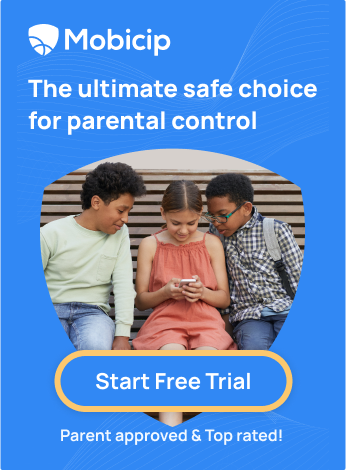How to Address TikTok Challenges with Children: A Guide for Parents

You're in the right place if you're wondering what TikTok is and why it has your kids hooked. TikTok is a social media platform where users express themselves through short videos, dance moves, and creative skits. It's a world where trends take flight in the blink of an eye.
Whether you're on an iPhone or an Android, TikTok has taken the world by storm. The numbers tell the story – in 2023, there are a whopping 102.3 million users in the U.S. alone, and it's projected to jump to 121.1 million by 2027! Now, let's talk about our kids. According to Business Insider, youngsters between 11 and 17 spend almost two hours daily on TikTok, making it the social media platform they use most.
TikTok isn't just about fun dance routines and lip-syncing. It comes with its own set of entertainment and risks. Some challenges are all laughs and giggles, while others can be questionable. We'll cover the spectrum from harmless fun to potential dangers so you're in the know.
This article guides you through understanding and addressing TikTok challenges with your young ones. We'll learn why kids are so enamored with these challenges and, most importantly, how to spot the potentially harmful ones and protect your child from the risks.
Why Kids Love TikTok Challenges
TikTok Challenges have become a magnet for kids, drawing them in with irresistible appeal. As parents, understanding the reasons behind this fascination can help navigate the potential dangers prowling in the digital landscape.
Low Barrier to Entry and Creative Control:
TikTok's simplicity is a double-edged sword. The ease of diving into challenges without elaborate setups makes it appealing to kids. With just a mobile and internet connection – you're all set! They enjoy the creative freedom it offers, allowing them to express themselves without needing fancy equipment.
Illusion of Fame and Being Part of Something New and Cool:
Kids crave recognition and a sense of belonging. With its vast audience, TikTok offers a virtual stage where every challenge completed feels like a shot at stardom. Imagine being talked about by peers in the classroom and neighborhood playgrounds. Being part of the latest trends provides a taste of being cool and relevant in their peer group.
Fun, Connection, and Belonging:
Beyond fame, TikTok is a place for creating and sharing. The platform becomes a hub of shared experiences, creating a sense of connection and belonging. Kids, driven by a desire for fun and friendship, find TikTok challenges as an engaging way to connect with others.
Learning New Skills and Expressing Themselves:
TikTok challenges often involve learning new dance moves, tricks, or creative expressions. Kids see it as an opportunity to acquire new skills while showcasing uniqueness. The platform becomes a canvas where they can paint their personality and talents for the world to see.
How to Identify and Prevent Harmful TikTok Challenges
Physical injuries or death from dangerous stunts or pranks
Real dangers lurk behind the seemingly harmless world of TikTok challenges, putting young minds at risk of physical injuries or even death. Many challenges involve dangerous stunts and pranks that can go horribly wrong. From attempting high-risk acrobatics to imitating perilous feats, the drive for social media fame has led some teens down a dangerous path. The consequences are severe, with reports of broken bones, concussions, and, sadly, even fatalities. The lure of likes and shares often blinds youngsters to the potential harm these challenges poses.
Cyberbullying or harassment from negative comments or feedback
The open nature of social media platforms exposes young users to the risk of receiving hurtful comments and unsolicited negative feedback(trolling). Negative remarks and hurtful feedback stemming from these challenges can deeply impact the mental and emotional well-being of our children. Cyberbullying can take various forms, from mean-spirited comments to the malicious spreading of rumors. This can lead to anxiety, depression, social withdrawal, academic decline, and even suicidal thoughts, impacting victims profoundly.
Exposure to inappropriate or adult content
TikTok challenges often lead kids into the vast and sometimes treacherous landscape of the internet. Here, content ranges from harmless fun to material entirely unsuitable for young eyes.TikTok, being a platform driven by user-generated content, poses inherent risks. Some challenges may inadvertently expose children to content that is not age-appropriate, from explicit language to images that can be distressing. Premature exposure to adult themes can affect their innocence and emotional well-being.
Addiction or obsession with social media validation
The quest for likes, comments, and followers has led many youngsters down a rabbit hole of constant digital comparison and self-worth tied to online approval. The pull of instant validation through likes on TikTok challenges can become all-consuming, impacting children's mental and emotional well-being. It's easy for kids to lose track of time and priorities as they chase the next viral trend or seek acknowledgement from their online peers. The pressure to conform to popular challenges and trends can also contribute to a sense of inadequacy among those who may not receive the same level of attention. This obsession with social media validation can lead to heightened anxiety, decreased self-esteem, and a distorted sense of reality.
Examples of Harmful Challenges:
The blackout challenge: Individuals attempt to hold their breath until they pass out, risking oxygen deprivation and serious health consequences.
The chroming challenge: Individuals inhale aerosol products to achieve a dangerous high, posing significant risks to their respiratory and overall well-being.
The Cha Cha Slide challenge: It involves swerving a car in sync with song lyrics, putting participants and others on the road at risk of accidents and injuries.
The skull breaker challenge: Intentionally tripping a person in mid-air while they're jumping, leading to severe injuries like fractures and concussions.
How can parents identify and prevent harmful TikTok challenges?
Stay Informed:
-
Educate yourself about the potential dangers of TikTok challenges through reliable sources.
-
Keep up with the latest trends and challenges circulating on the platform.
-
Read Mobicip Blog for digital parenting tips and tricks.
Educate Your Kids:
-
Talk to your children about the risks associated with specific TikTok challenges.
-
Ensure they understand the potential consequences of engaging in harmful trends.
Set Clear Rules and Boundaries:
-
Establish guidelines for using TikTok and other social media platforms.
-
Communicate what is and isn't acceptable behavior online.
Use Parental Control Apps:
-
Consider using parental control apps like Mobicip to monitor your kids' online activity.
-
Mobicip can help you set time limits for using TikTok or block it completely.
Regular Communication:
-
Engage in regular and open conversations with your kids about their online experiences.
-
Create an environment where they feel comfortable sharing any concerns or challenges.
FAQ
What are the most popular TikTok challenges?
TikTok challenges change a lot, but some classics stick around. Dance challenges are super popular, like the "Renegade" and "Savage Love." Lip-syncing challenges, where you act out scenes, are cool too. Challenges that transform you, like the "Glow Up Challenge," are fun. Challenges can also spread awareness, like the "Ice Bucket Challenge" did. Some challenges are just for laughs, like the "Flip the Switch" challenge.
How do I report a dangerous TikTok challenge?
If you spot a risky TikTok challenge, act fast to keep everyone safe. Open TikTok and find the video. Click the three dots in the corner for options. Hit "Report" and choose "Harmful behavior." Describe why it's dangerous. TikTok's team will review and take action. Share details, like the username and video link, if possible.
How do I limit my child's screen time on TikTok?
To manage your child's TikTok time, use a parental control app like Mobicip. First, download and install Mobicip on their device. Set up the app, create an account and link your child's device. In Mobicip, you can set daily time limits for TikTok. Schedule screen-free time for dinner or sleep. Monitor their activity and receive alerts. Adjust settings as needed. Mobicip helps you balance screen time, ensuring a healthy tech routine for your child.





